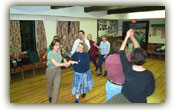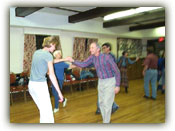 |





Learn more about contra dancing in the "Contra Dance Primer"
|
 |

The Country's First Dance Craze

Before hip-hop, before disco, even before swing or jazz…. there was contra. And let me tell you, it was all the rage. What is contra dancing exactly? A few days ago, I wasn't so sure -- but it had the word "dancing" in it, and I figured it would be right up my alley. We found out that contra is a form of American folk dance, but instead of doing any more research, we decided that the best way to learn is by experience. So Becky and I started searching for a place to get our contra groove on. It was a Tuesday -not the best night to find social gatherings such as a contra dance -- but being the resourceful trekkers that we are, we managed. With a little bit of investigation, we found out about some weekly dancing held at a Presbyterian church in Clemson, South Carolina… and we were on our way.
We walked in to find about a dozen people standing around on the hardwood floors, chitchatting and waiting for the fun to begin.
"We're here to contra!" we declared.
"This isn't actually a contra dance," someone replied.
Okay, so in reality we had stumbled upon an international folk dancing group. But they did contra as well, and graciously agreed to give us a taste. We danced away, and even got to do some English country and Israeli folk as well (with Becky reliving her high school youth group days). Dancing for a couple hours as more and more people trickled in, we had an absolute blast!
So now that I am the contra expert (yeah, right), I feel like I should share my impressions with you.
Contra, according to Neda... Contra dancing is:
- Historical: Hey, it's on the U.S. Trek website…there's got to be some history involved, right? Contra can really be seen as our country's first dance craze. It was the thing to do back in the 1800s! Contra has its roots in English country dancing, a much more formal and proper type of dance. English country dancing was done in royal courts and performed by individual partners, not by big groups. In the U.S., the idea of royalty had lost its glamour. People were not interested in being elegant and serious like those stuffy British monarchs. So, they adapted a more informal version of country dancing… and contra was born (the word itself actually came up as a mispronunciation of the word country)! The dance swept the nation and was based on big groups of people dancing together. Towards the end of the century, ballroom and polka and other more traditionally "couples" dancing took over and killed off contra-mania. But in the Northeast, especially in New Hampshire and Vermont, the contra dancing roots ran deep, and people continued to gather for some good contra times. Today, contra lives on all over the country!

|
 |
- NOT square dancing: but it is similar. "I may not be an expert contra dancer," I thought to myself before swinging onto the dance floor, "but hey, at least I have great square-dancing experience from elementary school gym class." I will even admit to having enjoyed going country line dancing a couple times with my friend Lindsay. Would either of these experiences be helpful in my quest to become a contra champ? Well, square dancing and contra are actually related. Square dances are when four couples dance in a "square" (imagine that), whereas contras are when many couples move up and down a long line and switch partners as the dance progresses. A lot of the basic moves are similar though, so when steps such as promenades or dos-e-dos were called, I knew just what to do.
And luckily for me and Becky, contra dancing is also:

|
 |
|



